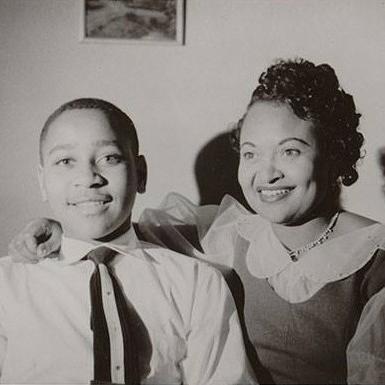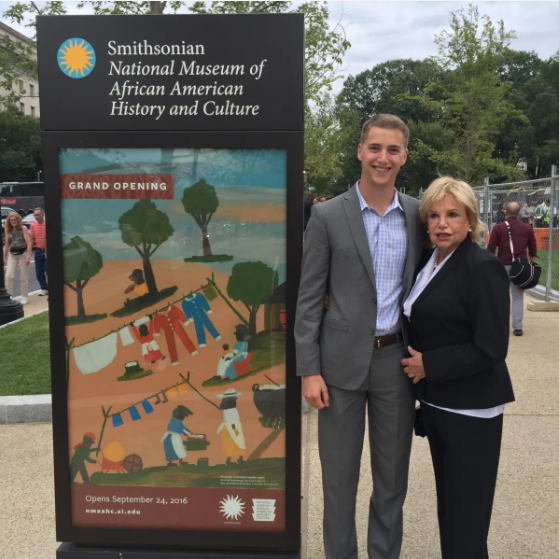Thacker's Part in the Emmett Till Casket Restoration
The story of Emmett Till, an African American teenager murdered in 1955, has been cited by many as the incident that sparked the Civil Rights Movement. Thacker was very proud to be a part of assisting the Smithsonian Institute in completing a multi-year restoration project of the original casket.

The Story of Emmett Till
Emmett Till was a 14-year-old African American who was visiting Mississippi from his hometown of Chicago when he was brutally murdered in 1955 for allegedly whistling at a white woman. His body was dumped in a river and was so brutally beaten that when it was discovered three days later, he could only be identified by a ring on his finger. Authorities attempted to bury his body immediately, but his mother, Mamie Bradley, requested his body be sent back to Chicago. Bradley insisted on having an open-casket funeral, displaying for all to see the brutality of the abuse of her son. Bringing to light Jim Crow segregation, this incident was later heralded as sparking the civil rights movement.

The Investigation Reopened in 2005
In 2005, Emmett’s body was exhumed as part of a new investigation into his murder. The State of Mississippi would not reopen the case without undeniable proof that the body buried was Till’s. After the autopsy, state law prohibited the original casket to be reburied, so it was set aside to be preserved. The original plan was for the casket to be on display with a memorial at the cemetery, but over the years the casket was moved to an outside shed where it sat for many years deteriorating. When Till’s family learned of the condition of the casket, they donated it to the Smithsonian Institute of African American History & Culture which was still under construction at the time.

The Smithsonian Sought Assistance from Thacker Caskets
When the Smithsonian took on the restoration project, Thacker Caskets headquarters was located just 5 miles from the research facility where the casket was being restored and examined. The Smithsonian did not immediately offer details as to what they were working on, but instead said they were doing “research on caskets.” Thacker invited the Smithsonian curators to their facility in Clinton, Maryland. After asking some questions and learning that the casket they were doing research on was for Emmett Till, Justin Thacker (who led the project) excitedly welcomed the opportunity for Thacker to serve this mission and help restore a part of American history.

Beginning the Restoration
When Justin Thacker arrived at the research facility to see Emmett Till’s casket for the first time, it was already completely disassembled by the Smithsonian in their efforts to analyze and catalog every single aspect of the casket to ensure the restoration would be done as accurately as possible. Justin accompanied the Smithsonian to the American Stripping Company in Manassas, VA to discuss the metal repairs, but the primary responsibility of Thacker was to recreate the interior of the casket. To reconstruct the interior as accurately as possible, the casket was sent to Thacker Caskets Manufacturing in Florence, Alabama on a truck dedicated solely to transporting the casket. Employees at Thacker Manufacturing were asked to set aside modern-day quality control policies and include all the imperfections that the original casket had.

Details of the Restoration
The original casket was a hinge cap, glass top sealer – where the glass sat on top of the casket box so guests could look through the glass at the body during visitation services. The majority of the time restoring the casket was spent in sourcing materials that were as close to original as possible, yet would stand the test of time being displayed at the museum. Through the restoration process, neither the Smithsonian nor Thacker were able to fully confirm the original casket manufacturer as the only identifiable markings were the numbers stamped into the metal of the shell, likely indicating the model number or shell type of the casket. Thacker relied on its more experienced long-time employees to be on the restoration team. Justin Thacker said, “They are more familiar than any book about casket interiors from decades ago. The head panels have completely changed, and our employees spent countless hours sewing the interior using a method specific to the time period.”

Completion of the Restoration
Upon completion of the work at Thacker’s manufacturing facility in Florence, Alabama, the Smithsonian curators put the casket on display at the manufacturing facility. Thacker production workers were invited to view the piece of history they were a part of! The casket was then shipped back to the Smithsonian research facility until it was taken to the new museum for its grand opening.

Emmett Till's Casket Exhibition in the Smithsonian
The Smithsonian of African American History and Culture officially opened on September 24, 2016 in which Justin Thacker and his grandmother Audrey Thacker were invited to attend. The museum’s founder, Lonnie G. Bunch III, and the museum’s curator, Linda Landry specifically sought out Justin and Audrey during the grand opening to thank them for Thacker’s assistance in the restoration. The casket is a permanent exhibition in the museum and is located in a room called, “Defending Freedom, Defining Freedom”. It is the only exhibit where no photography is permitted and a lone pew provides a place for visitors to pause and reflect. “We know that this museum will be visited by millions of people in years to come. If the casket plays a small role in getting that story told, then we could not ask for anything more.”

A Letter From the Smithsonian
In 2016 prior to the exhibit opening at the museum, Mary Ballard, Senior Textiles Conservator with the Smithsonian, sent Thacker Caskets a meaningful and thoughtful letter regarding the restoration project. She shared the Smithsonian’s thoughts on the process and what is like to work with Thacker, noting that though the team felt a bit anxious due to the context of the restoration project, they were “put at ease” by the experience of Thacker's team. She also commented that Thacker Manufacturing is full of “dedication, hard work, expertise, and ingenuity.”


Article in American Funeral Director
Following the opening of the Smithsonian, the leading funeral magazine, the American Funeral Director wrote a three-page article on the story of Emmett Till’s casket in its August 2017 edition. The article featured the story of Emmett Till, the historical significance of the casket itself and highlighted Thacker’s role in the restoration. The article followed the story all the way through the museum’s grand opening and interviewed the museum’s founding director Lonnie G. Bunch III.